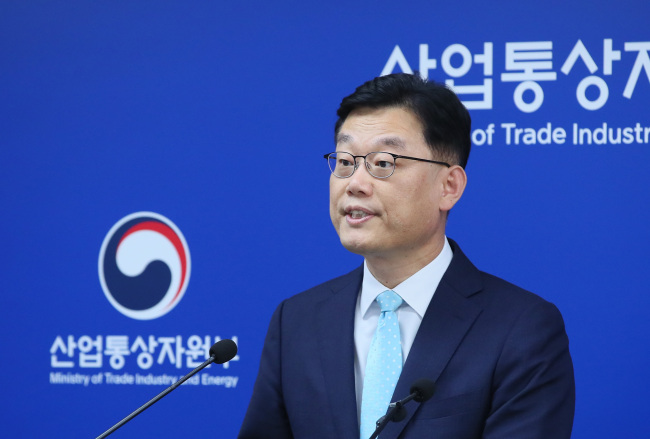May 2, 2019
Weak demand and depreciation of chips pull down exports, minister calls for swift execution of supplementary budget.
South Korea’s exports dropped 2 percent in April from the previous year, marking the fifth consecutive month of downtrend amid a prolonged slump in the chip-making business and sluggish demand from China, government data showed Wednesday.
The volume of outbound shipments totaled $48.86 billion in April, down from $49.85 billion a year earlier, according to statistics released by the Ministry of Trade, Industry and Energy.
Imports inched up 2.4 percent to $44.75 billion during the same period and the country’s trade surplus stood at $4.12 billion, extending the 87 consecutive months in the black.
Causing the decrease in export volume was the price depreciation of semiconductors and weak demand from China, according to the ministry.
Exports of semiconductors fell 13.5 percent on-year to $8.4 billion, while petrochemical products and steel moved down 5.7 percent to $3.89 billion and 7.7 percent to $2.65 billion, respectively.
Also, the average export price of chips slipped 51.6 percent during the given period, reflecting the inventory adjustment process of major global IT firms.
 |
Excluding the chip sales factor, however, exports moved up 0.8 percent in April, the ministry said.
Leading the general uptrend were ships, with exports soaring 53.6 percent to $2.7 billion. Automobiles also rose 5.8 percent to $3.75 billion won, continuing the steady growth.
By country, exports to China fell 4.5 percent on-year, extending the fall for the sixth straight month. Korea’s exports to ASEAN countries also fell 1 percent during the period, as the Southeast Asian states saw a decrease in their outbound shipments to China.
But the decelerating pace of exports slowed down, signaling a possible improvement in trade, the ministry added. The on-year decline of exports was 8.2 percent in March and 11.4 percent in February.
Also, the overseas sales of new product categories took an uptrend in April, with health care products rising 23.3 percent and rechargeable batteries rising 13.4 percent on-year.
“Despite the sluggish global economy and trade dispute between the United States and China, the decelerating pace of exports has slowed down to a certain degree, but the trade environment will continue to face challenges,” Minister Sung Yun-mo said.
Vowing all possible measures to nurture new industrial growth engines, including non-memory chips and future-generation vehicles, the minister also called for swift fiscal injection to revive the country’s trade.
“It is crucial to confirm and execute the 323.3 billion won that was allocated for the export revitalization fund in the supplementary budget.”


